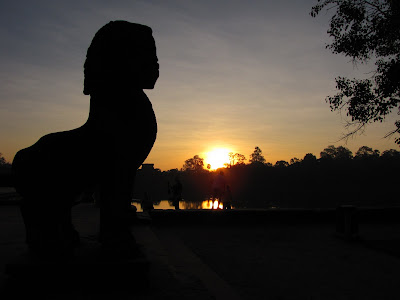
Our last day in Cambodia was jam packed with places to see. It began with an optional visit to Angkor Wat for sunrise and about half of the participants joined me. Unlike sunrise at the Taj Mahal, Angkor Wat was pretty busy and bustling with vendors ready to make a few dollars by selling coffee and tea.
Watching the sunrise with a handful of students, parents and a few hundred random people was a neat experience and made me use the token line of my SAS experience: ‘what is my life?’ Just as quickly as the sun came up, we were bussed back to the hotel for breakfast where we met the rest of the group for the day ahead. We went to a bunch of temples around Angkor Wat including an area where the movie Laura Croft: Tomb Raider was filmed.
 Most of the temples are in various stages of decay and are now being refurbished. My favorite was the Bayon temple or temple of faces. It is a Buddhist temple but has Hindu elements incorporated. Its main tower has huge stone face that some call the Mona Lisa of Southeast Asia on each side. There are 51 smaller towers surrounding Bayon, each with the four faces. I liked this temple so much that I bought a sandstone replica of the one of the faces. I’ll be excited to display it in my new home, once I find one.
Most of the temples are in various stages of decay and are now being refurbished. My favorite was the Bayon temple or temple of faces. It is a Buddhist temple but has Hindu elements incorporated. Its main tower has huge stone face that some call the Mona Lisa of Southeast Asia on each side. There are 51 smaller towers surrounding Bayon, each with the four faces. I liked this temple so much that I bought a sandstone replica of the one of the faces. I’ll be excited to display it in my new home, once I find one. I didn't take these two photos but I really like them and they are far better than the ones I took. Enjoy


We made our way back to Angkor Wat for our full tour where we got our history lesson. Thanks to scared-destinations.com I’ll give you a little lesson as well.
Built in the 12th century by the king of the prosperous Khmer empire, Angkor Wat was built as a royal temple dedicated to a Hindu deity. After the city of Angkor fell to invaders, Angkor Wat receded into the jungle but continued as a Buddhist temple and a pilgrimage site over the centuries. Angkor Wat is the best-preserved example of Khmer architecture in Cambodia and is so grand in design that some rank it among the Seven Wonders of the World. It appears on the Cambodian national flag, a very rare instance of a flag incorporating an image of a building. The "lost city" of Angkor first attracted the interest of Europeans in the 1800s after the French colonized Cambodia. Today, Angkor Wat continues to draw thousands of visitors anxious to see this remarkable ancient temple in the jungle. In addition to many tourists, Buddhist monks are daily visitors to Angkor Wat, their bright orange robes making a vivid contrast with the grey stone of the temple.To learn even more about Angkor Wat go to http://www.sacred-destinations.com/cambodia/angkor-wat








Our visit was a bit more hurried than I would have preferred but being the bus leader I didn’t feel appropriate leaving the group and tour guide to do my own exploring. It was back on the bus and off to the airport where we had a little drama that I really can't write about but resulted in a student being sent home. When we made it back to the ship I helped with the return process of my trip and one that arrived soon after mine, purchased a few things from the vendors stationed outside the ship and called it a night.
Nice shots!
ReplyDelete